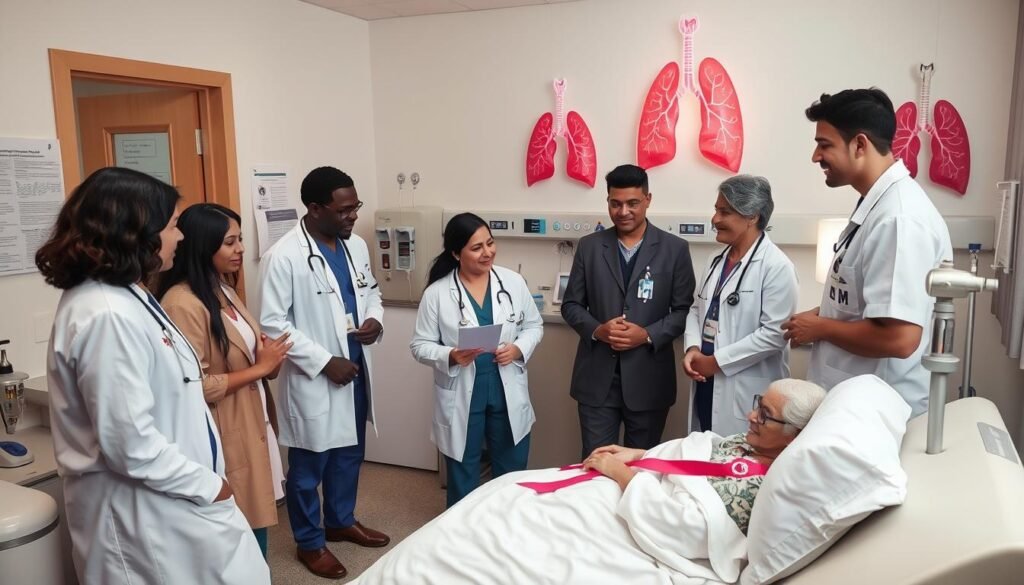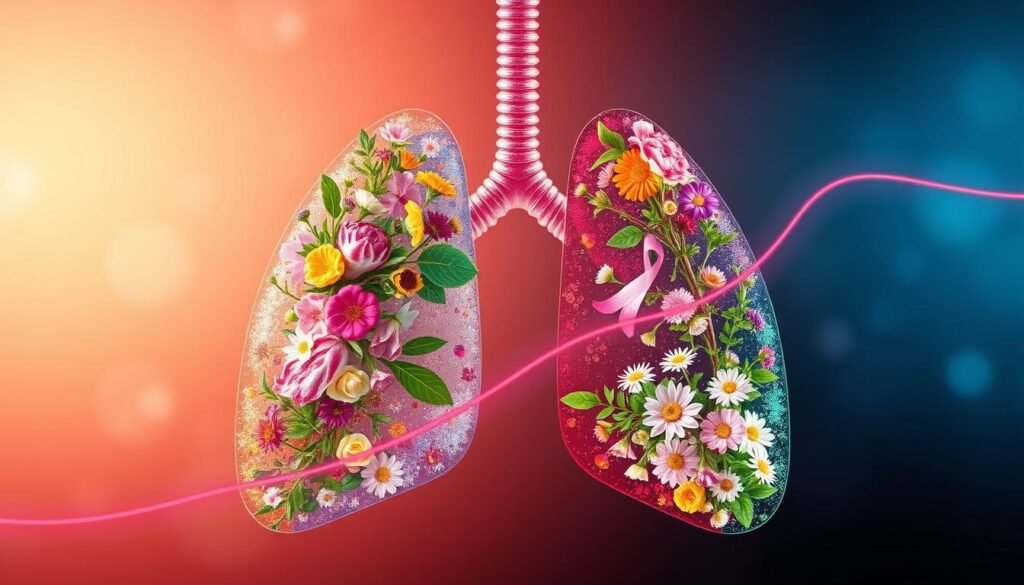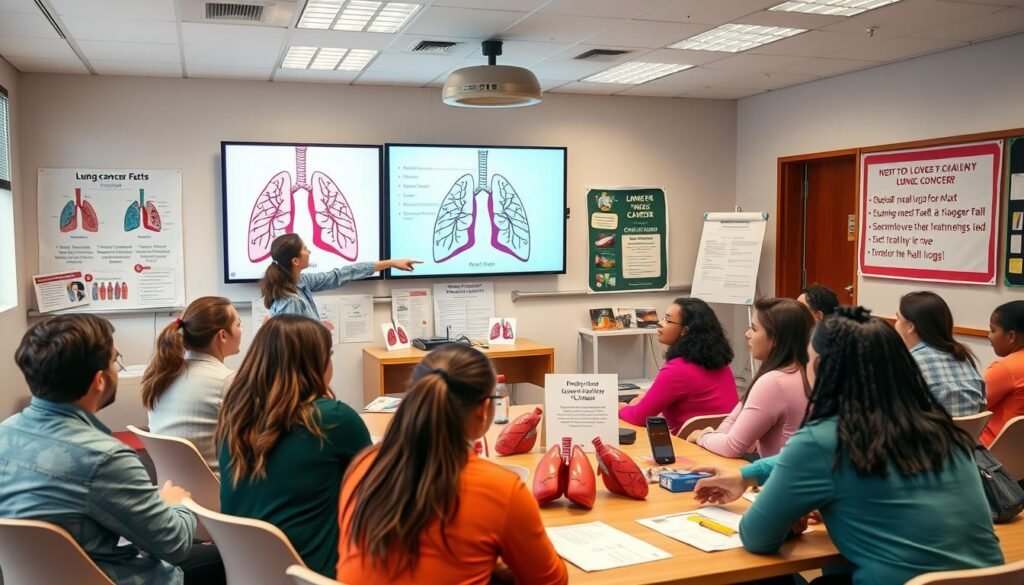It’s a surprise to many that 10% to 20% of people with lung cancer never smoked. This fact breaks the common idea that lung cancer is only for smokers. Lung cancer is a top cause of cancer death in the U.S., especially in women. Over the last 40 years, the number of women getting lung cancer has almost doubled.
Many myths surround lung cancer, causing fear and misunderstanding. Our goal is to clear up these myths with solid facts. By doing this, we hope to spread knowledge about lung cancer. This includes its treatment and ways to prevent it. Improving understanding of lung cancer can help everyone.
Key Takeaways
- 10% to 20% of diagnosed lung cancer patients have never smoked.
- Lung cancer is the second leading cause of cancer deaths in women.
- Approximately one-third of new lung cancer cases occur in individuals under 65.
- Secondhand smoke increases the risk of developing lung cancer by 20% to 30%.
- Despite common beliefs, non-smokers can also be at risk for lung cancer.
Introduction to Lung Cancer Myths
Many people have wrong ideas about lung cancer, which can cause problems. They think it’s a smoker’s disease only. But, about 10% of diagnoses are in folks who’ve never smoked. It’s key to clear up these common lung cancer misunderstandings to fight fear and stigma.
In 2005, lung cancer was a bigger threat to women than breast cancer. It took the lives of 69,078 women, while breast cancer claimed 41,116. This fact shows why it’s vital to correct lung cancer myths debunked for better awareness. Work-related exposures are also a big concern. They are behind 13% to 29% of lung cancers in men, showing how environmental factors matter too.
It’s important to teach people about the risks of lung cancer. This includes how menthol cigarettes and air pollution can be dangerous. Knowing these risks helps everyone make smarter health choices. To learn more about lung cancer risks, check this resource.
Understanding Lung Cancer
Lung cancer starts in the lungs, within the cells of its air passages. It’s important to know about it to grasp its effects on health. Learning about lung cancer helps with awareness and catching it early.
What is Lung Cancer?
Lung cancer is a top cause of cancer deaths in the USA. It mostly affects smokers but can also hit non-smokers. Interestingly, 10-20% of cases occur in people who’ve never smoked. This shows the importance of knowing all risk factors and lung cancer’s biology.
Types of Lung Cancer
There are two main kinds: non-small cell lung cancer (NSCLC) and small cell lung cancer (SCLC). NSCLC makes up about 80-85% of cases and grows slower than SCLC. SCLC progresses quickly and is mostly linked to heavy smoking.
Among these, adenocarcinoma is the most common, especially in adults under 46. Exposure to radon and secondhand smoke are key risk factors. Remember, knowing about lung cancer can help protect your health and spot early warning signs.
Common Myths About Lung Cancer
Many lung cancer myths spread in society, leading to inaccurate beliefs about lung cancer. It’s key to know the truth to increase awareness and prevention. Let’s discuss two major myths.
Myth #1: Lung Cancer is Only a Smoker’s Disease
It’s a common belief that only smokers get lung cancer. However, non-smokers can also get lung cancer; up to 20% of cases are in people who’ve never smoked. Exposure to radon, secondhand smoke, and pollutants plays a big role. Understanding this can boost awareness and prompt people to make healthier choices.
Myth #2: Smoking Doesn’t Matter if You’ve Already Started
Many think stopping smoking after years doesn’t help. Yet, quitting smoking dramatically lowers the risk of cancer. Indeed, the risk for lung cancer drops about 50% in ten years after quitting. Knowing that it’s possible to reverse some of the smoking damage can inspire people to quit for their health.
Debunking these lung cancer myths can change lives. Credible sources offer more insight into lung cancer realities and early detection’s role. Check out myths and facts about lung cancer for more information.
Myths About Lung Cancer Treatment
Lung cancer treatment has many myths that confuse people. It’s wrong to think all treatments are the same. Also, surgery isn’t the only way to fight lung cancer. Knowing the facts helps patients choose the best care.
Myth #3: All Treatments for Lung Cancer are the Same
The idea that all lung cancer treatments are the same is not true. In fact, treatments vary a lot. It depends on the cancer’s type and stage. Lung cancer treatment misconception is common but misleading.
Some may need surgery, while others benefit from chemotherapy or targeted therapies. It’s crucial to have a plan that fits the patient’s unique needs. This approach improves their chance of getting better.
Myth #4: Surgery is the Only Option for Lung Cancer
Thinking surgery is the only treatment for lung cancer is another myth. It’s a good option for some early-stage cancers. But there are many other treatments available. These include radiation therapy and clinical trials for new treatments.
Today’s lung cancer treatments offer many choices. These can help people live longer and better lives. It’s important to know all the options. This knowledge empowers patients to make informed decisions on their path to recovery.

Inaccurate Beliefs About Risk Factors
Knowing the truth about lung cancer risk factors is key to raising awareness. There are many wrong ideas about who can get lung cancer and what increases its risk. By correcting these myths, people can better prevent and detect lung cancer early.
Myth #5: Only Older Adults Get Lung Cancer
Some think lung cancer only affects older adults, which isn’t true. While it’s more common in older people, young adults can get it too, especially a type called adenocarcinoma. This type often occurs in those who’ve never smoked. Around 20% of lung cancer patients are in this younger group. That’s about 20,000 to 30,000 people each year. Knowing this fact emphasizes the need for lung cancer awareness for everyone, no matter their age.
Myth #6: Secondhand Smoke Doesn’t Increase Risk
It’s a myth that only smokers get lung cancer. Secondhand smoke also raises your risk by 20-30%. This wrong belief may stop people from avoiding secondhand smoke. It’s critical to spread the true facts about lung cancer risks. Understanding that even short times in secondhand smoke can be harmful is key to keeping communities healthy.
| Myth | Fact |
|---|---|
| Only older adults get lung cancer. | Lung cancer can occur in younger individuals, notably among non-smokers. |
| Secondhand smoke doesn’t increase risk. | Exposure to secondhand smoke increases lung cancer risk by 20-30%. |
Common Lung Cancer Misunderstandings
It’s key to know about lung cancer myths for awareness and prevention. Many don’t see that symptoms are often not obvious, leading to late detection. This shows why it’s vital to know the symptoms of lung cancer and the myths about smoking and the disease.
Myth #7: Lung Cancer Symptoms are Always Obvious
Many think lung cancer symptoms are easy to spot. But, symptoms usually start slow and are hard to notice early on. As a result, around 85% of cases are found after they’ve grown a lot. It’s important to know signs like:
- Persistent cough
- Chest pain
- Coughing up blood
- Unintended weight loss
- Shortness of breath
Myth #8: If You Don’t Smoke, You’re Safe from Lung Cancer
A big myth is that only smokers get lung cancer. But around 20% of patients never smoked. Things like genes and environmental toxins also play a role, showing everyone needs to be careful, smoker or not.
Since lung cancer is so serious, finding it early is crucial. Knowing the symptoms helps people get advice early, which is good for preventing late diagnoses. Understanding these myths can improve knowledge and push for timely check-ups, which are key for better health outcomes.
Myths About Lung Cancer Screening
Lung cancer causes more deaths in the U.S. than several other cancers combined. Yet, some people don’t understand lung cancer screenings. Knowing the truth helps overcome myths and shows why screening is key.
Myth #9: Stethoscopes Can Detect Lung Cancer
Some think a stethoscope exam alone can find lung cancer. This view misses the mark. Lung cancer screenings, especially low-dose CT scans, are crucial. They are recommended for people 50 to 80 who smoked a lot.
Early lung cancers, like Stage IA, can be caught with these scans. They have a cure rate of over 75% in five years. This shows why correct diagnostic methods are needed for early and accurate detection.
Myth #10: Lung Cancer Screenings Aren’t Necessary
A common myth is that lung cancer screenings aren’t needed. But research shows they can cut lung cancer deaths by 20%. Sadly, only 20% of those who should get screened actually do. This shows the need for more screening.
Medicare, Medicaid, and most insurances cover yearly screenings. They’re easy to get and use less radiation than other scans. Spotting symptoms early and getting screened can vastly improve your chances.
Myths About Lung Cancer Survival Rates
Some people think lung cancer always leads to death. This belief causes fear. Yet, knowing about the lung cancer survival rates and treatments can change that view. It’s about seeing the hope in recovery.
Myth #11: Lung Cancer is Always Terminal
Lung cancer is a tough fight, but not a lost cause. Treatments have gotten better, giving people hope. If found early, 65-85% of patients can live five more years. That’s why early detection and regular checks are key.

Around 10-20% of lung cancer patients never smoked. This shows other factors can cause it, too. Lung cancer is a top killer, especially in women, with cases doubling in 40 years. Yet, new treatments offer hope.
The table below shows early vs. late-stage lung cancer facts:
| Stage | 5-Year Survival Rate | Treatment Options |
|---|---|---|
| Early Stage | 65-85% | Surgery, Targeted Therapies, Immunotherapies |
| Late Stage | Less than 15% | Palliative Care, Chemotherapy, Immunotherapies |
Stopping smoking increases survival by 30-40%. Every fact about lung cancer shows early help matters. Knowing this can lead to smarter choices about care. It gives people control over their health.
Myths About Lung Cancer: Know the Facts
Lung cancer is a major issue in the U.S. It’s the third most common type of cancer here. In 2022, around 236,740 people were diagnosed with it. Sadly, about 130,180 died from it that year.
Not just smokers get lung cancer. In fact, 20% of lung cancer deaths are in people who never smoked. It’s crucial to challenge myths and learn the facts. Secondhand smoke, pollution, and chemicals also play roles. Knowing various causes helps in spreading awareness and education.
Understanding the Risks and Statistical Data
Most lung cancer patients are over 65, but younger folks can get it too. It’s important to know the symptoms. Many don’t show symptoms until it’s too late. Learning about early warning signs of lung cancer can save lives.
Quitting smoking does help, even after a lung cancer diagnosis. Eating fruits and vegetables might also lower the risk. These choices can make a big difference in preventing lung cancer.
Lung cancer causes more deaths worldwide than colon, breast, and prostate cancer combined. Knowing the truth about lung cancer can motivate people to look after their health better.
The Importance of Lung Cancer Education
Lung cancer education helps clear up many wrong ideas about the disease. It gives people the right information about risks, signs, and ways to treat it. This aids in understanding lung cancer better. A common wrong belief is that only smokers can get lung cancer. In truth, even though smoking is a major cause, about 20% of those who get don’t smoke. It’s important to know about all risks, including radon and secondhand smoke. These factors can also make lung cancer more likely.
It’s key to know how vital early detection is. For people who’ve smoked a lot, getting yearly lung scans can save lives. The aim is to catch the cancer early to better the chances of survival. Sadly, only 26% of lung cancer cases are found early. This is why education and getting checked are crucial to improving survival rates.
Lung cancer is not simple; it involves many factors and needs care made just for the patient. Knowing more can lead patients to get the right treatments. These can help slow down or reduce tumors. Every effort in learning more about lung cancer education is a big step in fighting the false beliefs. These wrong beliefs affect both prevention and treatment.

Conclusion
It’s crucial to know the truth about lung cancer to boost awareness and education. Every two minutes, someone in the U.S. gets diagnosed with lung cancer. It’s key for people to understand the facts and take control of their health.
Clearing up false beliefs, like the idea that only smokers get lung cancer, helps start better conversations. It also helps reduce the negative stigma linked to the disease. This is important for everyone to know.
Screening for lung cancer plays a big role in finding it early, which can save lives. Even though screenings could cut death rates by 20%, only 16% of those who should get screened actually do. More awareness about lung cancer screening can lead to early detection and improve survival rates.
Lung cancer is the top cause of cancer deaths worldwide, so education and advocacy are needed non-stop. If all eligible people got screened, we could save an extra 500,000 years of life. Taking steps now can make a big difference for the future.
Learning about lung cancer myths and facts is very helpful. For more information, click here to debunk common lung cancer.